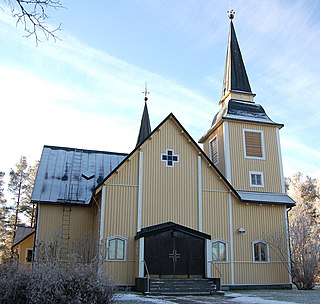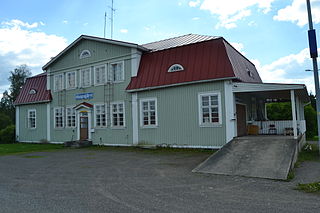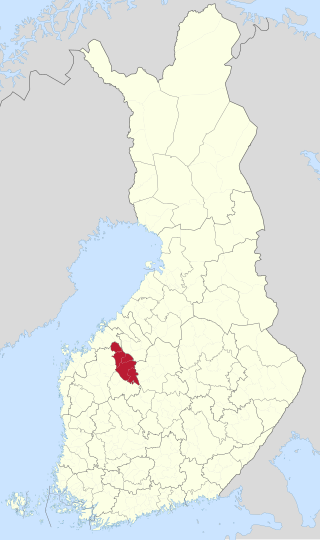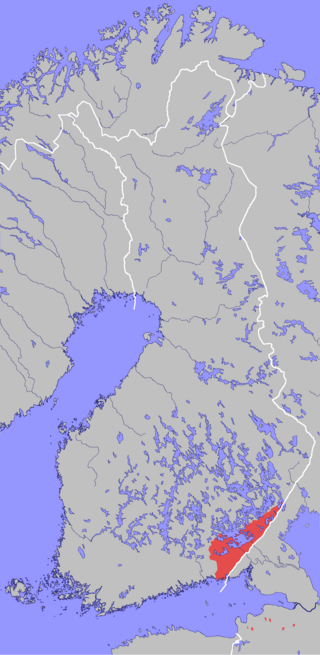In grammar, the inessive case is a locative grammatical case. This case carries the basic meaning of "in": for example, "in the house" is talo·ssa in Finnish, maja·s in Estonian, куд·са in Moksha, etxea·n in Basque, nam·e in Lithuanian, sāt·ā in Latgalian and ház·ban in Hungarian.

Kankaanpää is a town and municipality of Finland. Kankaanpää was founded in 1865, became a township in 1967 and finally a town in 1972. It is located in the crossroads of Hämeenkangas and Pohjankangas ridges. It belongs to the region of Satakunta. Kankaanpää has a population of about 12,500 inhabitants, which make it the third largest municipality in the Satakunta region in terms of population, after the city of Pori and the town of Rauma. Pori is located 53 kilometres (33 mi) southwest of Kankaanpää.

Vaala is a municipality in Finland. It is located in the North Ostrobothnia region. Established in 1954, the municipality has a population of 2,614 and covers an area of 1,764.04 square kilometres (681.10 sq mi) of which 461.45 km2 (178.17 sq mi) is water. The population density is 2.01 inhabitants per square kilometre (5.2/sq mi). Previously Vaala was part of the Kainuu region but was transferred to Northern Ostrobothnia on 1 January 2016.

South Ostrobothnia is one of the 19 regions of Finland. It borders the regions of Ostrobothnia, Central Ostrobothnia, Central Finland, Pirkanmaa, and Satakunta. Among the Finnish regions, South Ostrobothnia is the ninth largest in terms of population. Seinäjoki is the regional centre and by far the largest city in the area.

Ranua is a municipality of Finland. It is located in the province of Lapland. The municipality has a population of 3,641 and covers an area of 3,694.79 square kilometres (1,426.57 sq mi) of which 241.09 km2 (93.09 sq mi) is water. The population density is 1.05 inhabitants per square kilometre (2.7/sq mi).

Haapajärvi is a town and municipality of Finland.

Keuruu is a town and municipality of Finland. It is located in the province of Western Finland and is part of the Central Finland region. The municipality has a population of 9,240 and covers an area of 1,430.57 square kilometres (552.35 sq mi) of which 172.4 km2 (66.6 sq mi) is water. The population density is 7.34 inhabitants per square kilometre (19.0/sq mi). The town center and Haapamäki village are both the most populated places in Keuruu.

Konnevesi is a municipality of Finland. It is located in the former province of Western Finland and is part of the Central Finland region. The municipality has a population of 2,524 and covers an area of 680.85 square kilometres (262.88 sq mi) of which 167.95 km2 (64.85 sq mi) is water. Neighbouring municipalities are Hankasalmi, Laukaa, Rautalampi, Vesanto and Äänekoski. The municipality is unilingually Finnish.
Savonians are a subgroup (heimo) of the Finnish people who live in the areas of the historical province of Savonia.

Koillismaa is a subdivision of Northern Ostrobothnia and one of the Sub-regions of Finland since 2009.

Järviseutu is a subdivision of Southern Ostrobothnia and one of the Sub-regions of Finland since 2009.

Itä-Häme is the eastern part of the historical province Tavastia in Finland. It is in Päijänne Tavastia, Southern Savonia and Central Finland.

Southwest Finnish dialects are Western Finnish dialects spoken in Southwest Finland and Satakunta.

South Ostrobothnian dialect is a Western Finnish dialect. It is traditionally spoken in the region of South Ostrobothnia and parts of Coastal Ostrobothnia. The South Ostrobothnian dialect has many features that are unique to the region of South Ostrobothnia.

Värmland Finnish dialect is an extinct Savonian dialect spoken in Värmland by the Forest Finns. However some speakers also lived in Norway.
Kainuu people are Eastern Finnish inhabitants of the Kainuu region.

Central and Northern Ostrobothnian dialects are Western Finnish dialects spoken in Northern and Central Ostrobothnia, as well as in the Ranua municipality in Lapland. The dialects have been influenced by the Savonian dialects, the influence is weaker at the coasts and stronger in the inland areas.

South Karelian dialects, Karelian dialects or Southeast Finnish dialects are Eastern Finnish dialects spoken in South Karelia, along with eastern parts of Kymenlaakso. Prior to the Winter War, the dialects were spoken along the Karelian Isthmus and Ingria. However, the South Karelian dialect speakers from the parts of Karelia taken by the Soviet Union were evacuated into the rest of Finland where their speech was assimilated into the new environment. Use of the Ingrian dialects is declining.

Tavastian dialects are Western Finnish dialects spoken in parts of Western and Southern Finland. The dialect spoken in the city of Tampere is part of the Tavastian dialects. The Tavastian dialects have influenced other Finnish dialects.

Kainuu dialect is a dialect of Finnish spoken in Kainuu, Vaala, Koillismaa, Posio and Ranua. It belongs to the Savonian dialects, or more broadly, the eastern dialects of Finnish. Due to the region's close ties to North Ostrobothnia, the dialect has been influenced in vocabulary by Central and Northern Ostrobothnian dialects and vice versa.



















